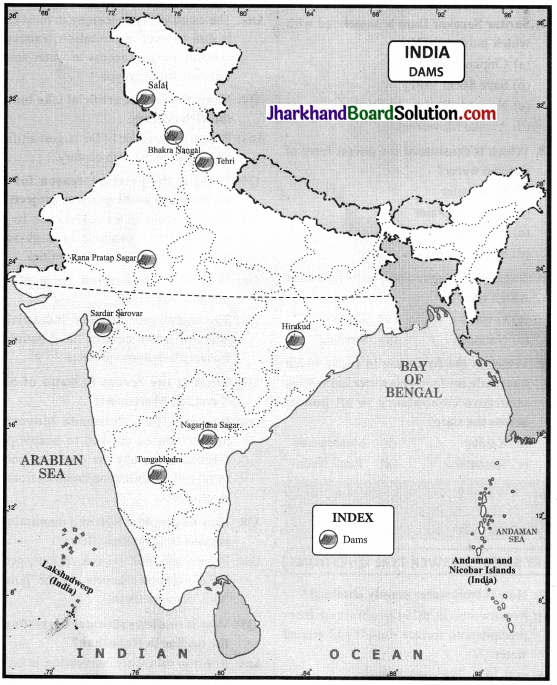JAC Board Class 10th Social Science Important Questions Geography Chapter 3 Water Resources
Multiple Choice Questions
Question 1.
How water is continually renewed and recharged?
(a) Nitrogen cycle
(b) Oxygen cycle
(c) Carbon cycle
(d) Hydrological cycle
Answer:
(d) Hydrological cycle
Question 2.
How much of the earth’s surface is covered with water?
(a) one-fourth
(b) two-fourth
(c) three-fourth
(d) half
Answer:
(c) three-fourth
![]()
Question 3.
By what year is it predicted that large parts of India will have absolute water scarcity?
(a) 2025
(b) 2052
(c) 2022
(d) 2021
Answer:
(a) 2025
Question 4.
What is the contribution of hydroelectric power in total electricity produced?
(a) 2.5 per cent
(b) 4 per cent
(c) 80 per cent
(d) 22 per cent
Answer:
(d) 22 per cent
Question 5.
Which project in the Mahanadi basin integrates conservation of water with flood control?
(a) Sardar Sarovar Dam
(b) Nagarjuna Sagar Dam
(c) Hirakud Dam
(d) Tehri Dam
Answer:
(c) Hirakud Dam
Question 6.
Which river is known as the ‘river of sorrow’?
(a) Narmada
(b) Sutluj
(c) Godavari
(d) Damodar
Answer:
(d) Damodar
![]()
Question 7.
Sardar Sarovar Dam is associated with which movement?
(a) Chipko Movement
(b) Save Silent Valley
(c) Narmada Bachao Andolan
(d) Appiko Movement
Answer:
(c) Narmada Bachao Andolan
Question 8.
Which is considered the purest form of natural water?
(a) Pond water
(b) Reservoir water
(c) Palar pani
(d) River water
Answer:
(c) Palar pani
Question 9.
Nagarjuna Sagar Dam is built across which river?
(a) Godavari
(b) Kaveri
(c) Narmada
(d) Krishna
Answer:
(d) Krishna
![]()
Question 10.
Which is the first state in India which has made roof top rainwater harvesting structure compulsory to all houses across the state? >
(a) Kerala
(b) Maharashtra
(c) Karnataka
(d) Tamil Nadu
Answer:
(d) Tamil Nadu
Very Short Answer Type Questions
Question 1.
How is freshwater mainly obtained?
Answer:
Freshwater is mainly obtained from precipitation, surface run-off and ground water.
Question 2.
Why does the availability of water vary over time and space?
Answer:
Availability of water varies over time and space because of the variations in seasonal and annual precipitation.
Question 3.
What is the cause of water scarcity in most cases?
Answer:
The cause of water scarcity in most cases is due to over-exploitation, excessive use and unequal access to water among different social groups.
Question 4.
Name the largest artificial lake built in the 11th century.
Answer:
Bhopal Lake is one of the largest artificial lakes built in the 11th century.
![]()
Question 5.
What is the primary reason for the resistance to multi-purpose projects?
Answer:
Primary reason of resistance to the multi-purpose projects is large-scale displacement of local communities.
Question 6.
Who have benefited from multi¬purpose projects?
Answer:
The landowners, farmers, industrialists and few urban centres have benefited from multi-purpose projects.
Question 7.
What is the recent demand of Save Narmada Movement?
Answer:
Recently, Save Narmada Movement has re-focused the aim to enable poor citizens, especially the displaced people to get full rehabilitation facilities from the government.
Question 8.
How do people of hills and mountainous regions irrigate their fields?
Answer:
In hills and mountainous regions, people build diversion channels like the ‘guls’ or ‘kuls’ for agriculture.
Question 9.
Why is rooftop rainwater harvesting on the decline in Rajasthan?
Answer:
Rooftop rainwater harvesting is on the decline in western Rajasthan as plenty of water is available from the perennial Rajasthan Canal.
![]()
Question 10.
On a political map of India, mark the following dams.
(a) Salal
(b) BhakraNangal
(c) Tehri
(d) Rana Pratap Sagar
(f) Hirakud
(e) Sardar Sarovar
(g) Nagarjuna Sagar
(h) Tungabhadra
